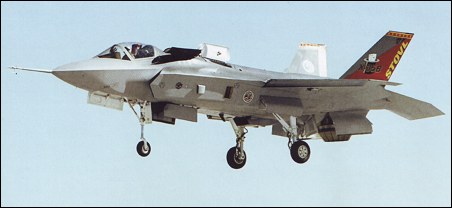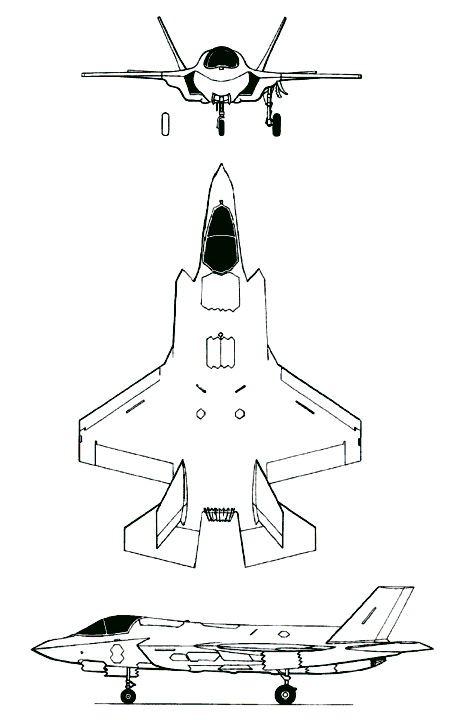 |
Lockheed-Martin X-352000 |  |
| JSF PROTOTYPE | Virtual Aircraft Museum / USA / Lockheed |
 |
The X-35 Joint Strike Fighter project originated in a 1980s requirement by the US Marine Corps and the Royal Navy that a replacement for the Sea Harrier and AV-8B would be needed early in the twenty-first century. Various research studies were undertaken on both sides of the Atlantic into advanced short take-off and vertical landing (STOVL) concepts, the most promising of which appeared to involve the use of a dedicated lift-fan located behind the cockpit. In 1989, DARPA (Defense Advanced Research Projects Agency) took over leadership of the advanced STOVL project and focused the on-going effort into a phased development programme leading to a flying demonstrator aircraft using the powerful new engines developed for the YF-22 and YF-23 Advanced Tactical Fighter. As the studies progressed, it was realized that a STOVL aircraft with the lift-fan removed and replaced by a large fuel tank would result in a fighter with excellent long-range capability. Such a fighter would fulfil the needs of the US Air Force, which was looking for a longer-ranged fighter capability in the light of Gulf War operations. So was born the Common Affordable Lightweight Fighter (CALF) project, aimed at producing a single aircraft design with both STOVL and conventional take-off and landing (CTOL) variants. In March 1993, study contracts were issued to Lockheed and McDonnell Douglas under the CALF project. In addition, Boeing and Northrop Grumman initiated private venture design studies. In 1995, CALF was absorbed into the Joint Advanced Strike Technology (JAST) programme, which was originally intended to focus on technology studies and demonstration of various equipment for next-generation strike aircraft. In fact, JAST soon evolved into a firm requirement for an advanced single-seat, single-engined lightweight multi-role fighter which could be operated by the USAF, US Navy and US Marine Corps in closely similar variants. In 1996, JAST was renamed JSF (Joint Strike Fighter), and in November that year Boeing and Lockheed Martin were awarded contracts to build two Concept Demonstrator Aircraft (CDA) -one CTOL version and one STOVL version - each. The aircraft were not intended to be fighter prototypes, but rather to prove that the selected design concepts would work, hence the use of X-series designations. The Boeing design received the designation , while the Lockheed Martin design was given the designation X-35. For the two Concept Demonstrator Aircraft, the designation X-35A was allocated to the CTOL version and X-35B to the STOVL version. Unlike Boeing, Lockheed Martin introduced a third version, the X-35C, to undertake simulated aircraft carrier (CV/CTOL) testing. This aircraft was produced by converting the existing X-35A after it had completed its planned flight trials. The Lockheed Martin X-35A and X-35B possess very similar airframes, including the aft cockpit bulge and associated doors for the lift-fan, which is only fitted to the X-35B. The Lockheed Martin X-35A made its first flight on 24 October 2000 from Palmdale, California. Robert Jackson "The Encyclopedia of Aircraft", 2004 External links
|  COMPANY PROFILE | |||||||||||||||||||||||||||||||||||||||||||||
 |

|

